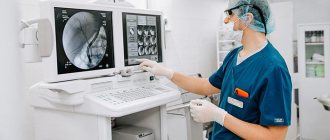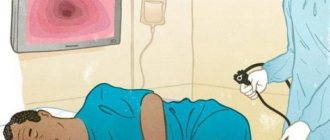Patients with suspected pathologies and diseases of the pelvic organs are prescribed various examinations and various diagnostic methods are used. These include: ultrasound examination, radiological examination, diagnostic laparoscopy, hysterosalpingography, etc.
The type and number of tests and diagnostic methods are prescribed individually, in accordance with the indications and medical history. Each method has its own characteristics of indications, implementation and results.
What is hysterosalpingography
This procedure is a method of studying the patency of the fallopian tubes and uterus. This study is also called HSG. Hysterosalpingography is an informative method and is often used in gynecology. The GHA allows you to confirm or refute the following violations:
- obstruction of the fallopian tubes,
- malformations of the pelvic organs,
- the presence of neoplasms of various types (fibroids, polyps, endometrial cancer, adhesions).
This procedure is usually prescribed to women who cannot conceive a child.
Questions and answers about tubal patency
Question: How is the patency of the fallopian tubes checked? I heard from friends that in Nalchik they check the patency of pipes very painfully, they even lose consciousness. P.Kh., Nalchik. Answer: The patency of the fallopian tubes is checked using ultrasound and x-ray diagnostics. More modern, informative, painless and physiological is checking the patency of the tubes using the Echo HSG method. Cost of checking the patency of the fallopian tubes WITHOUT PAIN
Question: Is it possible to check the patency of the fallopian tubes in the presence of the husband? I'm very afraid of pain! Yu.N., Krasnodar. Answer: Tubal patency under ultrasound control in our Clinic is a modern, painless procedure. The presence of a spouse is not required.
Question: I would like to check the patency of the tubes at your Fertility Clinic. Do I also need to make an appointment with a gynecologist before the procedure? Or after the procedure to decipher the results? How many days in advance do I need to register? O.B., Stavropol. Answer: Tubal patency is performed in our Infertility Treatment Clinic by appointment by calling 8 (800) 500-52-74 (toll-free within Russia) or +7 3-4 days before the visit.
The RESULT of checking the patency of the tubes will be communicated IMMEDIATELY after the study.
| 3D photo of a fetus at 12 weeks. Pregnancy occurred naturally 3 months after checking the patency of the tubes in our Clinic |
Question: Can a tube patency test be performed in your Clinic? M.Kh., Nazran. Answer: The examination necessary to check the patency of the fallopian tubes can be carried out in our Clinic. Cost of examination
Question: Tubal patency can be checked at what age? A.N., Rostov-on-Don. Answer: Checking the patency of the fallopian tubes is possible at any age in the absence of pregnancy within 1 year of regular sexual activity without contraception (without protection).
| 3D photo of the fetus at 15-16 weeks. The arms cover the face, the umbilical cord is between the legs. Pregnancy occurred naturally 2 months after checking the patency of the fallopian tubes in our Clinic |
Question: How is the patency of pipes checked? I'm very afraid of pain. In 2008, I had the patency of my tubes checked using an X-ray method. I almost died from pain. How painful is a tubal patency test at your clinic? K.Sh., Armavir. Answer: Thanks to the use of a modern pump, the increase in compression (pressure) when checking the patency of the fallopian tubes in our specialized Clinic occurs slowly and painlessly. Thus, checking the patency of the fallopian tubes under ultrasound guidance is a painless and comfortable ULTRA-MODERN method for diagnosing tubal patency.
| 3D photo of a fetus at 20 weeks. Brain research. A 40-year-old woman became pregnant two months after checking the fallopian tubes for patency and artificial insemination in our Clinic. |
Question: Can the patency of the fallopian tubes be checked in the presence of hydrosalpinx? E.G., Krasnodar. Answer: It is undesirable to check the patency of the tubes in the presence of hydrosalpinx due to even greater filling of the impassable fallopian tube with fluid with the risk of its rupture.
Question: How is tubal patency checked using tubal ultrasound? Sh.K., Derbent. Answer: Tubal patency using sonography is performed at the Women's Health Clinic in Pyatigorsk absolutely painlessly, in comfortable conditions, within 20-25 minutes. Pre-registration by phone (calls within Russia are free).
Question: I checked for obstruction of the fallopian tubes at the antenatal clinic. They said everything was fine, but I couldn’t get pregnant. My husband insists on checking the patency of the tubes in your Clinic. Relatives who became pregnant after the GHA echo told him about you. Tell me, does it make sense? E.Ya., Cherkessk. Answer: Checking the patency of the fallopian tubes under ultrasound control allows us to identify the so-called functional tubal factor of infertility - a condition in which the fallopian tubes are formally passable (like a hose), but peristalsis (rhythmic contractions that promote the advancement of the egg) is absent. In addition, ultrasound-guided tubal patency is both a diagnostic and therapeutic procedure. Based on our experience, up to 27% of patients become pregnant in the same or the next menstrual cycle after HSG.
| 3D photo of the fetal face at 36 weeks. Pregnancy occurred in the next menstrual cycle after checking the patency of the fallopian tubes |
Question: How to prepare for checking the patency of pipes? N.V., Kislovodsk. Answer: Checking the patency of tubes under ultrasound control at the Women's Health Resort Clinic does not require special preparation. The necessary examination includes a smear on the flora of the vagina and cervix.
Question: I’m going to come to you for tubal patency. Tell me, please, what exact address should I contact? You have 2 addresses listed. T.S., Essentuki. Answer: The patency of pipes is checked at the address Pyatigorsk, st. 295 Infantry Division 19, bldg. 4.
Question: Are there any restrictions on performing a tube patency test? T.E., Baku. Answer: An absolute contraindication to checking tubal patency is the presence of an inflammatory (infectious) process in the genital organs (colpitis, cervicitis, endocervicitis, endometritis, salpingitis).
| 3D photo of a fetus at 24-25 weeks. Pregnancy in a 39-year-old woman preparing for IVF occurred 2 months after checking the patency of the tubes in our Clinic |
Question: After checking the patency of the tubes, do you give pictures of the fallopian tubes? I need images of HSG tubes for IVF. Thank you. S.N., Grozny. Answer: When checking the patency of the fallopian tubes, all stages of the echo-contrast passage (entry of echo-contrast into the fallopian tubes, advancement and evacuation into the pelvic cavity) are described in detail and recorded on thermal paper (i.e., on the printer paper of the ultrasound machine). Thus, checking the patency of the pipes is documented.
The patency of pipes in our specialized Clinic is checked in accordance with the requirements of the Order of the Ministry of Health of the Russian Federation dated August 30, 2012. No. 107n “On the procedure for using assisted reproductive technologies, contraindications and restrictions on their use.”
However, a number of doctors still prefer x-ray hysterosalpingography, HSG with the usual image on x-ray film. It is advisable to discuss this issue with your doctor.
Question: I have already contacted 2 clinics regarding infertility treatment. They couldn't help me anywhere. What special thing do you use? I'm losing hope. M.F., Ust-Kamenogorsk, Kazakhstan. Answer: We consider illness as a manifestation of spiritual and emotional disturbance, disagreement with Self and unreasonable opposition of Self to circumstances and the surrounding reality. We start with psycho-emotional testing, streamlining feelings and thoughts, carry out complex treatment with medicines of natural origin, physiotherapy and spa factors... The effectiveness of our method has been PROVEN BY TIME and with successful results in infertility treatment.
| 3D photo of a fetus at 28 weeks. A 37-year-old woman became pregnant 2 months after checking the patency of the fallopian tubes and artificial insemination in our Clinic |
Question: My local gynecologist sent me to you to check the patency of the tubes and said that I cannot be sexually active. But it didn't work out. What to do? SHOULD I FLY TO YOU or not? F.V., Astana. Answer: It is better to postpone the tubal patency test to the next cycle.
| 3D photo of the face of a fetus at 30 weeks. A 26-year-old woman became pregnant after 6 months of treatment in our Clinic |
Question: I checked the patency of the tubes and was told that the left tube was obstructed and the right tube was passable. I have two children, can I still get pregnant? A.Zh., Karachaevsk. Answer: If the fallopian tubes are patent on one side and there are no other causes of infertility, the chances of pregnancy are 50%.
Question: My husband and I underwent treatment for hidden sexually transmitted infections. When can I come to your Fertility Clinic and have my tubes checked for patency after taking antibiotics? Zh.F., Volgograd. Answer: The patency of the tubes is checked after complete cure of latent sexually transmitted infections according to the results of control studies.
| 3D photo of pregnancy 31 weeks. Left hand of the fetus. Pregnancy in a 44-year-old woman with one fallopian tube occurred after 5 months of treatment in our specialized Fertility Clinic |
Question: Do you check the patency of your pipes WITHOUT PAIN? L.A., Georgievsk. Answer: Tubal patency is checked under ultrasound control at the Women's Health Resort Clinic WITHOUT PAIN. You can be sure of this!
Question: My husband and I calculated that CHECKING the patency of the tubes without pain in your Fertility Treatment Clinic, even taking into account the flight, is CHEAPER than here in Moscow. How can I get to you? O.I., Moscow. Answer: Checking the patency of the tubes and seeing an experienced gynecologist for infertility by appointment by multi-line phone 8 (800) 500-52-74 (calls within Russia are free), or +7 (for foreign calls), or the Women's Health Resort Clinic in Pyatigorsk is open NO WEEKENDS or holidays.
| 3D photo of a fetus at 34 weeks. The baby is sleeping. Pregnancy in a 28-year-old woman with primary tubal infertility after 5 months of treatment in our Clinic |
Question: Tubal patency, where do you recommend getting an ultrasound of the tubes to check for patency in Pyatigorsk without pain? A.M., Ust-Kamenogorsk, Kazakhstan. Answer: Tubal patency without pain! can be checked at the Infertility Treatment Clinic in Pyatigorsk (calls within Russia are free), or +7 (928) 022-05-32 (for calls from anywhere in the world), or [email protected]
Question: Where is pipe patency in Nalchik done painlessly? V.S., Nalchik. Answer: It is not possible to check the patency of pipes without pain in Nalchik. The patency of the tubes can be checked without pain only at the Women's Health Resort Clinic in Pyatigorsk.
Question: Who does echo geezge without pain? M.A., Cherkessk. Answer: An HSG echo without pain can be done at the Women’s Health Resort Clinic in Pyatigorsk.
Question: Is it possible to check the patency of pipes in Pyatigorsk at your own request or only on the direction of a gynecologist? L.K., Stavropol. Answer: You can check the patency of the tubes and do an HSG at the direction of the gynecologist or at the request of the woman.
We check the patency of pipes WITHOUT WEEKENDS and holidays:
Monday - Friday from 8.00 to 20.00, Saturday - Sunday from 8.00 to 17.00.
Patency of pipes by appointment by multi-channel phone 8 (800) 500-52-74 (calls within Russia are free), or +7 (for calls from anywhere in the world), or
Question: “The resort clinic for women’s health operates both for paid services and in the voluntary health insurance system.” In the voluntary health insurance system, is it covered by medical policies? Can you explain please! Answer: We accept Insureds at SOGAZ, AlfaStrakhovanie, Alliance, Ingosstrakh under policies issued by these insurance companies. You can find out detailed information about which medical institutions your insurance company works with by calling your insurance company’s hotline number. If the Women's Health Resort Clinic is not on its list, you can leave a request and, perhaps, your insurance company will meet you, enter into an agreement with us, and we will be happy to accept you. Sincerely, Chief Accountant of the Women's Health Resort Clinic.
Question: To check the patency of pipes in Pyatigorsk using POLIS, what is needed: a referral from a doctor, or is just desire and an insurance policy enough? V.N., Zheleznovodsk. Answer: To check the patency of the tubes, you should contact your insurance company to obtain a cover letter. If you have a cover letter, you can check the patency of the tubes in our Clinic. At the appointment you must have your passport and insurance policy with you. Sincerely, Chief Accountant of the Women's Health Resort Clinic.
Question: Do you provide documents to obtain a tax deduction when checking the patency of pipes? M.A., Krasnodar. Answer: The Women's Health Resort Clinic provides documents to obtain a tax deduction for tubal patency testing (13% tax refund).
THE INFERTILITY TREATMENT CLINIC is open seven days a week and on holidays:
Monday - Friday from 8.00 to 20.00, Saturday - Sunday from 8.00 to 17.00.
Checking the patency of the tubes and seeing an experienced gynecologist for infertility by appointment by multi-line phone 8 (calls within Russia are free), or (for foreign calls).
Pipe permeability price 6050.00 rubles
Patency of the fallopian tubes price 6050.00 rubles
The cost of pipe patency is 6050.00 rubles
The cost of tubal patency is 6050.00 rubles
The cost of a consultation with an experienced gynecologist to diagnose the causes and treatment of infertility is 3,400.00 rubles
| ONLINE information about pipe patency can be found at: [email protected] SIGN UP ONLINE for pipe patency in Pyatigorsk here. |
Subsections
- SUCCESSFUL infertility treatment
- CAUSES of infertility
- The sacrament of conception
- Checking the patency of the fallopian tubes
- Immunological factor of infertility: antiovarian antibodies, antisperm antibodies
- Genetic causes of infertility
- Postcoital test (Shuvarsky-Guner test)
- Measuring basal temperature and maintaining a graph
- Artificial insemination
- Program No. 3. Treatment of female infertility
- Miscarriage
- Our children
- Our mothers
- Questions and answers about infertility treatment
- Reviews about infertility treatment in our Clinic
- How to prepare for an appointment with a gynecologist?
Research methods
There are two ways
carrying out hysterosalpingography -
examination using X-rays and ultrasound.
Based on these methods, doctors can determine tubal obstruction or pathological intrauterine abnormalities.
During HSG, a small amount of contrast agent is injected into the uterine cavity and fallopian tubes using x-rays. During the procedure, doctors take several pictures in which you can see the condition of the pelvic organs.
In hysterosalpingography, a saline solution is injected into the uterus using ultrasound and a machine is used to examine the uterus and fallopian tubes.
The ultrasound examination method is considered the most preferable and safe, since during its conduct the woman is not exposed to harmful x-ray radiation.
The advantages of HSG using ultrasound include the following factors:
- no pain,
- this method does not cause allergies,
- The entire procedure takes only half an hour.
Advantages of contacting MEDSI
- Experienced doctors.
The clinic’s gynecologists regularly improve their skills and have the necessary skills and knowledge not only for diagnosis, but also for further elimination of detected pathological conditions and diseases. Specialists understand all the intricacies of female reproductive health, can quickly make an accurate diagnosis and prescribe adequate treatment - Comfort of visiting the clinic.
We ensured there were no queues. It is also important that the clinic is located near a metro station. This is convenient both for residents of the capital and for those who come to MEDSI from other localities for examination and further in vitro fertilization - Maximum painlessness of the procedure.
HSG is performed using a special catheter. It does not cause significant discomfort to the patient - Modern expert class equipment.
It allows examinations to be carried out with minimal radiation exposure and minimal discomfort, as well as accurate results. Thanks to this, patients are not exposed to any risks - Quality and accessibility of the examination.
We not only provide high diagnostic accuracy, but also adhere to a loyal pricing policy
To sign up for hysterosalpingography (HSG) of the fallopian tubes in Moscow, to find out the cost of diagnostics, just call us at . The specialist will select the optimal time to visit the clinic. You can also make an appointment using the SmartMed app.
Specialized centers
Reproductive Health Center
- Experienced specialists in the field of reproductive health
- Wide range of medical services
- Laboratory of Assisted Reproductive Technologies (ART)
More details
Hysterosalpingography technique
The technology of both types of research is carried out according to similar principles. During hysterosalpingography using X-rays, the woman is given antispasmodics and sedatives half an hour before the procedure. They relieve anxiety, relieve muscle spasms and make the procedure easier.
The patient is positioned on the gynecological surgery table. The pelvis should be at the edge of the table, the legs should lie on special holders and bent at the knees. The doctor treats the external genitalia with a disinfectant. Using mirrors, the doctor exposes the cervix. A special syringe is used to inject 2–3 milliliters of contrast agent into the uterus, after which an image is taken.
At the second stage, 3–4 millimeters of contrast are again injected into the uterus. The pressure pushes the substance through the fallopian tubes. If they are passable, then the fluid passes through them and enters the abdominal cavity. At this time, the doctor takes a second picture. Thirty minutes later, a third x-ray is taken, if necessary. After undergoing the examination, the woman must lie down for 50–60 minutes.
If the study is carried out using ultrasound, then not a contrast agent is injected into the uterine cavity, but 80 - 100 milliliters of sterile saline solution. The doctor then performs a vaginal ultrasound examination.
Where is it held?
The procedure is performed in the operating room and only in it
. Although this is an x-ray examination, it cannot be carried out in an x-ray room. This procedure must be carried out under sterile conditions, that is, the conditions must be the same as, for example, during operations on the heart or spine. Such conditions cannot be achieved in an X-ray room. Who sat in this place in front of you and with what illnesses? Therefore, only in the operating room.
If you decide to have an HSG done in our clinic, then the cost of hysterosalpingography (the price of the HSG procedure itself) is 10,000 rubles
.
The final cost of hysterosalpingography includes anesthesia and 3 hours of stay in our hospital, observation by doctors and nurses
and is
20,900 rubles
.
From October 1, 2021, the cost of GHA increases by 5,000 rubles.
Preparation for the procedure
A special contrast agent injected into the uterus is toxic. It can harm the embryo or cause fetal rejection. Therefore, throughout the entire cycle in which the procedure will be performed, the couple must be protected from pregnancy.
If a doctor examines a woman using x-rays, the following recommendations should be followed:
- From the beginning of the menstrual cycle until the day of the examination, the woman should abstain from sexual relations.
- the study is carried out in the first half of the cycle, on days 6–12 (preferably one day before ovulation) with a 28–30 day cycle. At this time, the endometrium is still thin, it will not be able to distort the condition of the uterus and tubes.
- Before hysterosalpingography, you should take a general blood test, blood for syphilis, AIDS and hepatitis, and a urine test to determine the cleanliness of the vagina.
- on the eve of the study, it is necessary to completely empty the intestines by doing a cleansing enema, or using other methods of bowel cleansing.
- In the morning, before the procedure, you should wash your genitals well, shave your pubic hair, and empty your bladder.
- The study is carried out on an empty stomach, it is allowed to drink no more than a glass of clean water without gas.
If hysterosalpingography is performed using ultrasound, then the woman follows similar recommendations. The exception is that the procedure is performed with a full bladder.
The research procedure is carried out without the use of anesthesia. It is not very painful, although it is unpleasant. If a woman has a high pain threshold, she should consult a doctor about possible pain relief methods.
How to prepare?
Preparation for the examination largely determines its informativeness and effectiveness. That is why a woman needs to strictly follow the recommendations given by the doctor.
Since the HSG procedure of the fallopian tubes has a number of contraindications, you should make sure that there are none.
As part of your preparation you should:
- Stop using vaginal tablets, suppositories and sprays for a week
- During the procedure, use contraception or refuse sexual intercourse to prevent the possibility of conception
Hygiene procedures should be carried out several hours before diagnosis. The study has nothing to do with food intake, so you should not limit yourself in food.
Since the HSG procedure of the fallopian tubes has a number of contraindications, you should make sure that there are none. To do this, the patient undergoes some tests.
Typically, a set of studies includes:
- Blood test for HIV, hepatitis and syphilis
- Flora smear
The exact list of studies will be announced by the doctor. In some cases, a preliminary ultrasound of the pelvic organs is performed.
On what day of the cycle is HSG performed?
The best period for hysterosalpingography is the period between menstruation and ovulation. Typically, the examination is carried out on days 7-12 of the cycle.
The best period for hysterosalpingography is the period between menstruation and ovulation. Typically, the examination is carried out on days 7-12 of the cycle.
When you can and should perform an HSG, your gynecologist will tell you. He will select the optimal day for diagnostics and answer all questions in advance. This will allow you to properly prepare for the examination and increase its accuracy.
Contraindications for the study
There are a number of contraindications to hysterosalpingography:
- pregnancy - contrast agent is dangerous for the development and life of the embryo,
- sensitivity to components introduced into the uterus - women may develop a severe allergic reaction,
- acute inflammatory processes occurring in the genitals,
- with 3 – 4 degrees of vaginal cleanliness,
- acute infectious diseases,
- vein thrombophlebitis,
- uterine bleeding.
Expert opinion of a doctor
Malakhova Victoria Yurievna
Reproductologist, obstetrician-gynecologist
The diagnostic value of hysterosalpingography for determining the causes of infertility is high. You can immediately examine the uterine cavity and oviducts. Visually see structural anomalies (bicornuate, saddle-shaped), pathologies (polyps, myomatous nodes, synechiae), diseases (hydrosalpinx), adhesions, bends. Determine the level of obstruction and the possibility of prompt elimination.
Contraindications to the procedure:
- acute infectious diseases;
- inflammatory processes of the organs of the reproductive system;
- varicose veins, accompanied by the formation of blood clots;
- menstruation;
- period of childbearing and breastfeeding;
- malignant tumors of the cervix;
- dysfunction of the thyroid gland;
- allergy to iodine;
- renal, hepatic and cardiovascular failure.
If there are contraindications, the doctor will suggest other, safer examination methods.
Interpretation of GHA results
The images show how the contrast fills the uterine cavity, penetrating the fallopian tubes. If the patency of the fallopian tubes is normal, then the contrast agent passes through them, then it ends up in the abdominal cavity.
If the patency of the fallopian tubes is impaired, the contrast agent will fill them to a certain level. In this case, the doctor identifies an obstruction and prescribes further treatment.
Hysterosalpingography helps to identify not only obstruction of the fallopian tubes, but also confirm the presence of various intrauterine pathologies.
Indications
This diagnostic method is chosen by gynecologists for patients with suspicion and to identify various diseases and pathological changes in the uterine cavity.
Tubal obstruction
Pathology is one of the causes of infertility and occurs if there are congenital or acquired ailments in the anatomy of the tubes (after surgery or functional disorders).
Isthmic-cervical insufficiency - expansion of the cervical canal and its internal os to 5-7 mm
Premature pathological dilation of the cervix, causing spontaneous abortion or premature birth. ICI occurs with congenital malformations of the uterus, injuries received during childbirth, after surgery, with hormonal disorders, etc.
Anomalies of the development of the uterus and appendages
Anomalies and malformations of the uterus include any changes in shape, location, size, etc. Their presence leads to disruptions in the reproductive system and various functional disorders. Without treatment, problems can lead to infertility, pregnancy complications, and miscarriage. Most often, illnesses occur without symptoms, so a high-quality diagnosis is needed.
Submucous fibroids or synechiae (adhesions in the uterine cavity)
Myomas, synechiae and other intrauterine pathologies are often diagnosed as a whole group in one patient (almost all age groups). Pathologies have similar symptoms and require an integrated approach to diagnosis and treatment.
Adenomyosis, endometrioid cancer, polyps, genital tuberculosis
Various lesions of the uterine mucosa are usually associated with infectious or viral diseases, hormonal disorders, inflammation, etc. and serve as signals of serious problems in the female body. Polyps arise and develop against the background of pathologies such as cervicitis or cervical erosion. Adenomyosis affects other tissues of the uterus. Genital tuberculosis leads to cycle disorders, intoxication, infertility, etc.
Possible consequences of HSG
Complications from this procedure are quite rare. The main negative consequence is an allergy to the contrast agent injected into the uterine cavity and fallopian tubes. If the technology for conducting HSG has been violated, then the woman’s appendages may become inflamed.
Many experts believe that pregnancy occurs easier after hysterosalpingography. The procedure promotes the conception of a child and increases fertility in women. If there were no violations after the study, then the married couple can plan a pregnancy in the next menstrual cycle.
Sedation or local anesthesia?
HSG must be performed under sedation. Sedation
- This is not general anesthesia, which has very unpleasant consequences, but drug-induced sleep, which has no side effects.
Carrying out HSG under sedation is necessary because with local anesthesia (or without anesthesia at all), a person cannot completely relax, and this, in turn, does not allow the uterus to relax. As a result, an incorrect diagnosis may be made. That is, you will be squeezed, the contrast will not be able to pass through the uterus, and the doctor may decide that you have an obstruction. You don't want to get a wrong diagnosis, do you? This is why we perform HSG only under sedation.
so that you get the most objective picture possible.
Recovery period after the study
Recovery occurs within 3-7 days after the procedure. Women often experience bleeding that goes away after a week. Bleeding is due to the fact that the cervix is slightly injured during the procedure. They usually occur in women suffering from erosion. Patients may be bothered by pain in the lower abdomen, but they quickly pass without taking painkillers.
For 3 days after hysterosalpingography, women should not take hot baths and should refrain from visiting baths, saunas and sexual intercourse.
If you dream of becoming a mother, but you are unable to get pregnant, then you can safely contact the IVF Center clinic in Arkhangelsk. The specialists of our center will definitely help you. You will be advised by experienced and qualified doctors. Here you can undergo a full examination, do hysterosalpingography, and assess the condition of the pelvic organs. You will receive high-quality conservative treatment. If necessary, an IVF procedure will be carried out.
What contrast agent is used for HSG?
To carry out the procedure, the introduction of a contrast liquid, which has the ability to block x-rays, is indicated. These are drugs such as:
- Cardiotrust. This is a contrast agent that can contain 50% and 30% iodine.
- Urotrast, Triombrast and Verografin. These are three analogues belonging to the group of radiopaque agents, which can contain 60% and 76% iodine.
Interestingly, hysterosalpingography was first attempted with Lugol's solution in 1909. But due to irritation of the peritoneal cavity and uterus, this attempt was unsuccessful. A year later, the Lugol's solution was replaced with bismuth paste, and then with argyrol and collargol. However, it was not possible to achieve the desired effect using these substances. In addition, all of them entailed inflammatory processes of the peritoneum.
It was only in 1925 that the scientist Heuser first used Lipiodol (a drug containing iodine) for hysterosalpingography. This substance made it possible to clearly visualize the condition of the uterus and fallopian tubes, and also did not harm the woman’s health. Since then, the procedure has been introduced into medical practice.










